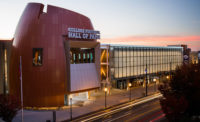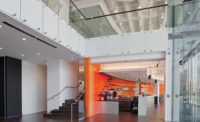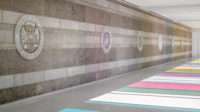Miramar, Fla.
Region Southeast
Project Team
Owner General Services Administration
Design Architect Krueck + Sexton Architects
Architect of Record Gensler
Contractor Hensel Phelps
Program Manager Jacobs
Structural Engineer Walter P. Moore and Associates
MEP Engineer Syska Hennessy Group Inc.
By going beyond owner-mandated minimum standards and using digital tools to enhance safety measures and outcomes, the team building the $157-million Benjamin P. Grogan and Jerry L. Dove Federal Building in Miramar, Fla., made sure to sweat the project’s numerous, complicated details. Named for two FBI special agents killed during a 1986 shoot-out in Miami, the complex, four-building facility—located on a 20-acre site near the Everglades—totals 383,000 sq ft and includes executive, private and team offices, conference space, a fitness center, computer-training facilities and an armory.
The project team had to meet government-specified blast requirements while providing the capability to withstand 180-plus-mile-per-hour wind forces. To do it, the design team incorporated a progressive-collapse concrete structure with an intricately customized curtain-wall facade for the signature six- and seven-story office towers, which, in total, measure more than 303,000 sq ft. A six-story “link” structure connects the two differently shaped buildings.
To build the complex design and allow construction to proceed without interruption, design-builder Hensel Phelps and design-build architect Gensler implemented multiple design reviews at intervals that exceeded the owner’s contract requirements, project team members say: While the General Services Administration’s (GSA) usual requirements call for design reviews at 35%, 60%, 90% and 100%, builders opted to implement a more stringent process.
Under that process, design-builders performed design reviews at the prescribed GSA milestones as well as when multiple packages were submitted. Contractors described the “extensive” process as a “necessary component” to deliver the project on schedule, which was dependent upon an early start to construction. Overall, builders say, this approach proved the best match for successfully maintaining fast-tracked construction without disruption.
Lead designer Gensler responded to the GSA’s emphasis on the idea of “connectivity” by designing the building to seemingly respond to its surrounding environment. The architect did this through the use of the irregularly shaped curtain-wall exterior, which reflects and refracts light from the nearby wetlands, thus creating a dynamic design aesthetic.
The building’s state-of-the-art skin curves in two axes on one side, while the other side comprises a highly faceted system of angular planes. Facilitating these complex geometries required standardizing the advanced window-and-screening system, while ensuring that the curtain wall met Miami-Dade County’s wind-load requirements, considered the most stringent in the country.
The team used building information modeling throughout the course of the project, from the schematic design phase through construction, which assisted with MEP coordination. For other trades, such as the curtain-wall contractors, BIM served as a design-assist tool that builders used to optimize the system’s fabrication.
Project team members also used BIM to enhance safety performance. Project contractors used the digital tool during the planning process to visualize and analyze safety conditions throughout the course of construction, a strategy that helped to identify future hazardous conditions and then plan the best approaches for each situation in order to ensure a safe jobsite. Specifically, builders say this use of BIM gave them the ability to extract detailed dimensions, discover trade coordination conflicts, focus on proper equipment selection, identify the most appropriate safety equipment and facilitate safety training. For example, builders used BIM to establish safe swing radiuses for cranes working on site.
The facility is certified LEED Platinum-Core and Shell, LEED Gold-Commercial Interiors and Sustainable Sites Initiative-Two Star.







Post a comment to this article
Report Abusive Comment